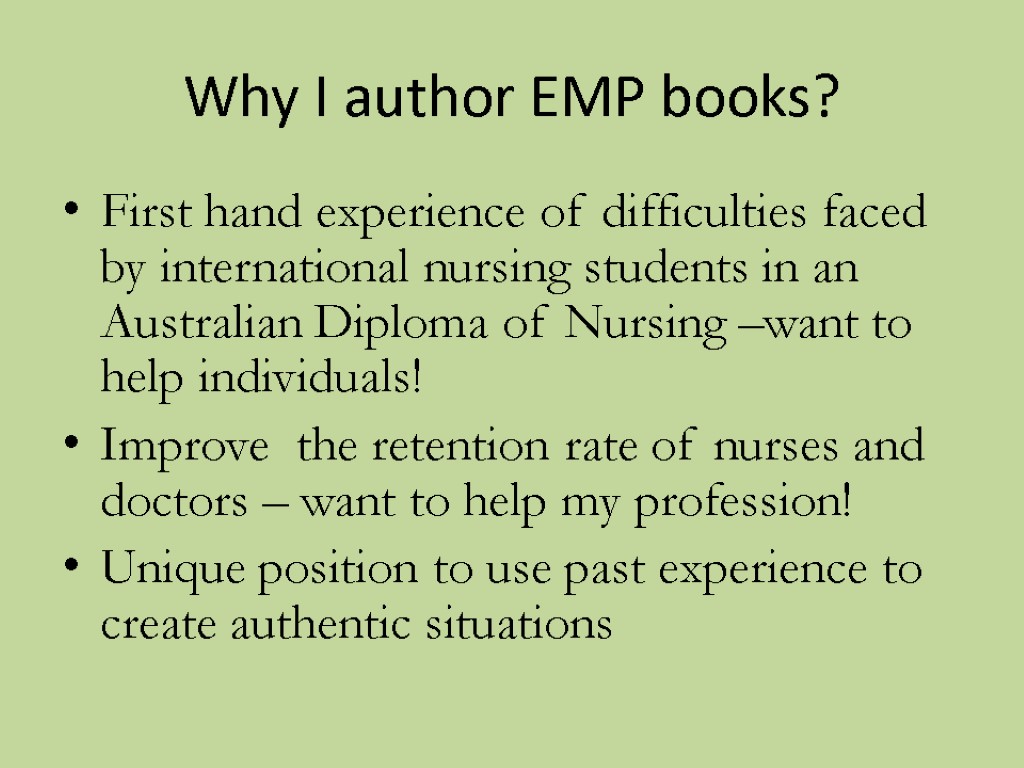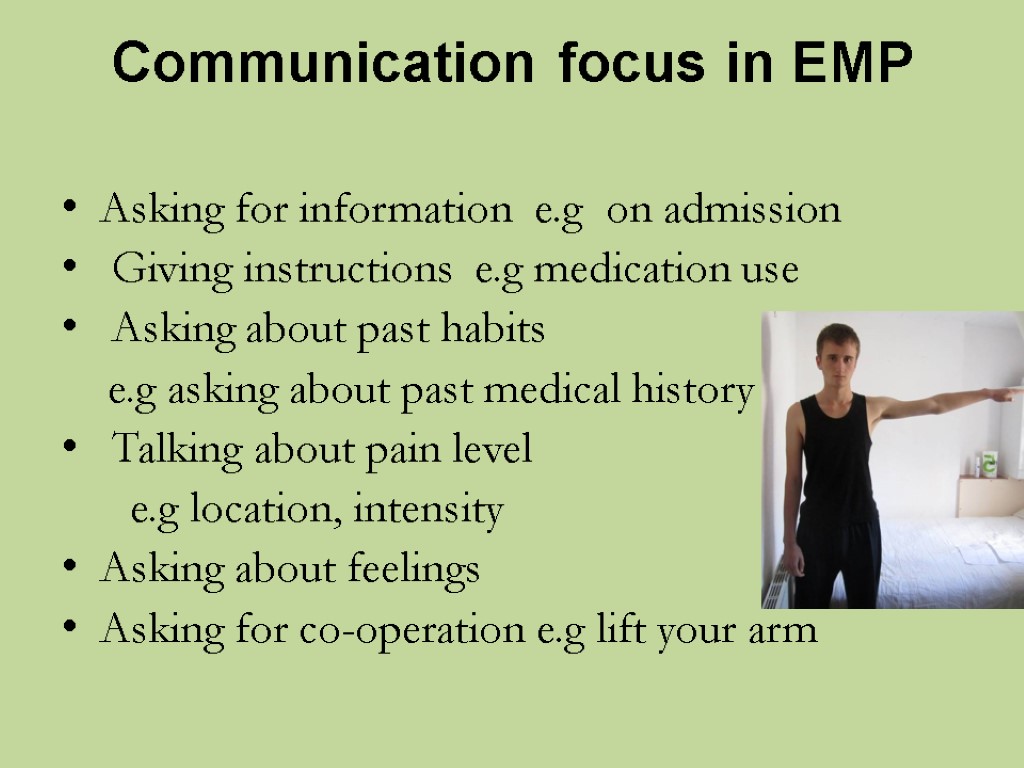English for Medical Purposes. Background to starting in


English for Medical Purposes

Background to starting in EMP teaching and authoring Start BA/LLB then → Nurse Training →BA Set up Home Nursing Service 1985-1990 Nurse Facilitation 1990 Move into TESOL 1990 (General English) Development of English for Nursing and Health at TAFE – Advanced Level and Study Tours Cross-over to Diploma of Nursing + international student support Return to clinical practice 2006 - currently RN in SW England

EMP authoring and consultancy Co-author ‘Cambridge English for Nursing’ books Author EMP materials (journals, online course, EMP books ) Development of Teacher Training Seminars with Ros Wright and Marie McCullagh Volunteer ‘Teachers Without Borders’ - development of teacher training resources Consultant in English for Medical Purposes

Feel free to contact me Email: [email protected] Blog www.englishfornursingandhealth.blogspot.com Website: www.e4nursingandhealthcare.com Facebook: English for Nursing and Healthcare Skype: virginiajaneallum

Why I author EMP books? First hand experience of difficulties faced by international nursing students in an Australian Diploma of Nursing –want to help individuals! Improve the retention rate of nurses and doctors – want to help my profession! Unique position to use past experience to create authentic situations

Background to the need for EMP Changes in language testing for doctors and nurses in the UK Nursing and Care Quality Forum (Sally Brearley) – set up to discuss improvements in patient care including language competency Safety issue Increases participation in global medical research area

English for Medical Purposes can be.. Workplace orientated course (overseas or in own country) PAL training for university course (degree, Masters) Part of local curriculum – more European degrees undertaken in English Online course + or – f2f sessions Academic – conference participation, journal articles

What type of course are you delivering? Needs analysis essential PAL Remember courses often need to fit in with shifts Online courses – accessible any time f2f – essential for communication scenarios Blended learning – time to ‘think about’ and review content

English for Doctors/Nurses – workplace oriented course Communication focus Appropriate writing focus Medical terminology and everyday health terminology Appropriate reading focus

English for Doctors/Nurses – academic course Communication focus – conference presentation Communication focus – conference / forum participation Professional development course attendance Authoring journal articles

Why are EMP courses necessary? Specialised vocabulary Need for accuracy in communication (safety) General English courses – limited use in healthcare environment Healthcare environment can be pressured Other similar courses –Oil and Gas, Aviation

Communication focus in EMP Asking for information e.g on admission Giving instructions e.g medication use Asking about past habits e.g asking about past medical history Talking about pain level e.g location, intensity Asking about feelings Asking for co-operation e.g lift your arm

Finding resources A lot more available to general public Books , online courses, online materials, blogs Health information e.g Patient UK, Medline Plus BBC Health, ABC Health Uni sites – resources for medical students, nursing students etc Greater need for authentic/near authentic material

Always keep in mind In most cases, your students will have the background in medical/nursing area They know the procedures They know the equipment They know the medical terms (possibly similar to English ) YOU ARE NOT TEACHING CONTENT

Adapting authentic materials Remember to remove any logos - privacy Some charts and policies are available online e.g SAGO Some medical/nursing institutions will give copies of charts (as long as the hospital logo is removed) Look for course books/online courses with authentic resources

SBAR SAGO

Nursing video

Using the video Ask students to identify the equipment used in the video Ask students to explain the process described in the video. What does the nurse/doctor do first? First, she asks the ‘patient’ for permission to take a BP reading. Then she … Students write a role play which matches the video. Role play the dialogue.

Using online resources: Puzzlemaker http://puzzlemaker.discoveryeducation.com/CrissCrossSetupForm.asp http://puzzlemaker.discoveryeducation.com/code/BuildCryptogram.asp

Crossword Look at the crossword example : Taking a patient’s blood pressure’ In pairs, complete the crossword. Students can produce their own crosswords . Exchange crosswords with a class-mate.

Cryptograms

Learning medical terminology Essential part of any EMP course Best integrated within each lesson Memorising + placing in context Use as many tricks as possible to minimise tedium!

Prefix charades Divide class into two groups Start Group A – one person select a card Role play the prefix e.g Hypo = low Group B – guess the prefix If unable to guess the prefix, Group A gets the point and so on…

Follow on to… Fill in the missing vowel Give each student a handout, face down Ask students to turn over and start First to finish, call out! Read through prefixes – students call out the meaning

Networking and finding contracts LinkedIn – share experience, job market Blogs and websites – make your own Consultancy – new area EMP a wide area – specialise in a particular area Build up profile –contribute to magazines, journals, blogs

references http://www.wales.nhs.uk/sitesplus/documents/861/Additional%20Info%20048.pdf http://nswhealth.moodle.com.au/DOH/DETECT/content/00_worry/when_to_worry_07.htm
english_for_medical_purposes.ppt
- Количество слайдов: 26

